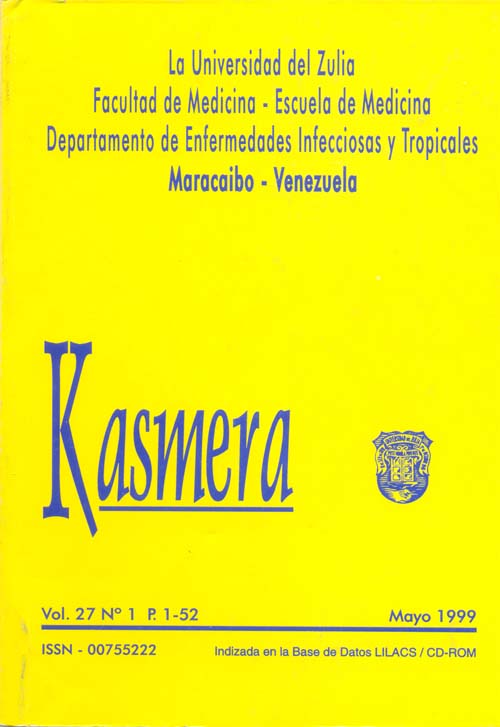Prevalencia de enteroparasitos en una comunidad rural venezolana
Abstract
Se realizó un estudio epidemiológico en una región rural de los Andes venezolanos, (El Dividive, Edo. Trujillo), con la finalidad de determinar el perfil de enteroparásitos. Se seleccionaron aleatoriamente 332 viviendas y se procedió a encuestar y realizar exámenes parasitológicos de las muestras fecales de 1.124 personas. La mayoría de las viviendas contaba con servicio de acueducto intradomiciliario muy irregular (69,9%), el 30% no poseía instalaciones sanitarias ni cloacas, el 40,7% no tenía sistema de recolección de basura intradomiciliaria. El promedio de edad fue de 23 años; sólo el 26,8% de los habitantes había concluido la educación primaria, el 13,7% tenía empleo fijo, el resto se dedicaba a oficios domésticos, actividades agrícolas y al comercio informal. En el 72,3% de las muestras, se pudo detectar la presencia de al menos un tipo de parásito; el poliparasitismo se evidenció en el 66% de los sujetos y sólo el 27,8% fue negativo al examen de heces. Se observó predominio de los protozoarios (83,7% ) sobre los helmintos (16,3%). Los parásitos más comunes fueron: Blastocystis hominis 38%, Endolimax nana 28,6%, Entamoeba hystolitica 24,2%, Entamoeba coli 14,3%, Entamoeba hartmanni 11,3%, Giardia lamblia 9.3%, Ascaris lumbricoides 10,3%, Trichuris trichuria 6,0% y otros 8,0%. Se evidenció, en esta población de precarias condiciones socioeconómicas: elevada presencia de parasitosis (72,3%) y alto grado de poliparasitismo. Se concluye que, en esta región, el escaso saneamiento ambiental está estrechamente asociado al nivel de parasitosis.
Copyright (c) 2009 H Urdaneta, JA Cova, Alfonzo N, M Hernández

This work is licensed under a Creative Commons Attribution-NonCommercial-ShareAlike 4.0 International License.
Kasmera journal is registered under a Creative Commons an Attribution-NonCommercial-ShareAlike 4.0 International (CC BY-NC-SA 4.0), available at: https://creativecommons.org/licenses/by-nc-sa/4.0/deed.en; which guarantees the freedom to share-copy and redistribute the material in any medium or format and adapt-remix, transform and build from the material, provided that the name of the authors, the Department of Infectious and Tropical Diseases, Zulia´s University and Kasmera Journal, you must also provide a link to the original document and indicate if changes have been made.
The Department of Infectious and Tropical Diseases, University of Zulia and Kasmera Journal do not retain the rights to published manuscript and the contents are the sole responsibility of the authors, who retain their moral, intellectual, privacy and publicity rights. The guarantee on the intervention of the manuscript (revision, correction of style, translation, layout) and its subsequent dissemination is granted through a license of use and not through a transfer of rights, which represents the Kasmera Journal and Department Infectious Diseases, University of Zulia are exempt from any liability that may arise from ethical misconduct by the authors.
Kasmera is considered a green SHERPA/RoMEO journal, that is, it allows self-archiving of both the pre-print (draft of a manuscript) and the post-print (the corrected and peer-reviewed version) and even the final version (layout as it will be published in the journal) both in personal repositories and in institutional and databases.











_pequeño1.png)

_pequeña.png)









_pequeña.png)




_pequeña.jpg)






